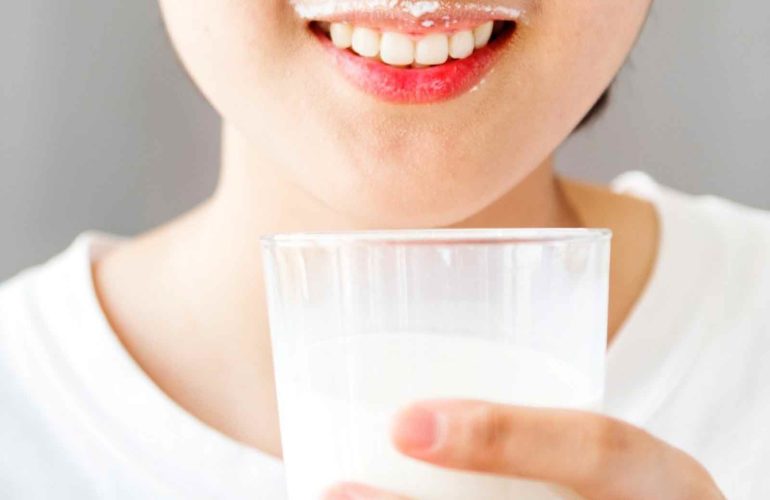Milk has been around for thousands of years. By definition, milk is a nutrient rich fluid that female mammals produce to feed their young. The most commonly used milk comes from cows, buffalos, sheep and goats. Milk consumption is always a hotly debated topic in the nutritional world, so you might wonder whether it’s healthy or harmful. This article covers all the important aspects of milk consumption.
Nutritional facts (100 ml milk)
| Cow milk (full fat) | Cow milk (toned) | Cow milk (fat free) | Buffalo milk (toned) | |
| Carbs | 5 g | 4.7 g | 4.2 g | 5.1 g |
| Protein | 3.8 g | 3.3 g | 2.9 g | 4 g |
| Fat | 3.5 g | 3 g | 0.2 g | 5.5 g |
| Calcium | 150 mg | 102 mg | 74 mg | 201 mg |
Cow vs Buffalo Milk
Cow Milk
- Cow milk is low in fat, protein and calcium
- It is high in sodium and is light on the stomach
- Cow milk is considered good for children and brain development
Buffalo Milk
- Buffalo milk is high in fat, protein, calcium and phosphorus
- It is low in sodium and potassium and lasts longer
- Buffalo milk is good for bones, teeth, muscles and weight gain
Other facts about milk
Carbs
- Carbs in the milk are mainly in the form of a simple sugar called lactose, which constitutes around 5 % of the weight of milk
Protein
- Protein in milk can be divided into two groups based on their solubility in water. Insoluble milk are called casein (80%) and soluble protein are called whey (20%)
Fat
- Whole milk, straight from cow is around 4% fat. In many countries, marketing of milk is mainly based on the fat content. Whole milk is 3.25% fat, whereas reduced fat milk is around 2% fat. Low fat milk has around 1% fat

Milk Processing Methods
Pasteurization
- This is the process of heating milk to destroy potentially harmful bacteria that are occasionally found in raw milk
Homogenization
- In raw milk, fat globules have a tendency to stick together and float to the surface of milk
- Homogenisation is done by heating the milk and pumping it through narrow pipes at high pressure
- Purpose of homogenisation is to increase slelf life and give it a richer taste and whiter colour
Having milk in the wrong way can lead to side effects
- Drinking milk in the morning can lead to indigestion and bloating
- However, people who are trying to gain weight or build muscles can drink milk in the morning
Best time to have milk
- Best time to have milk is in the evening or before bed time
- Milk contains enzymes that help in reducing sleep
- Milk is a source of trptophan, an essential amino acid, which means it is not produced by the human body. Trytophan is a precursor for serotonin, a neurotransmitter which is converted to melatonin. Both of these are known to enhance sleep and help in relaxing the brain
Do not consume milk like this
- Do not consume milk in cold form
- The molecular structure of milk in cold form is very different than boiled milk. Make sure you heat up the milk at least once before using it
- Don’t consume milk with salty food
- Avoid taking milk in morning tea or coffee. Caffeine in tea / coffee will prevent absorption of many essential vitamins and minerals in your body
- Don’t add milk to curries or gravy
- Don’t combine milk with any other form of protein
- Don’t combine milk with any citrus fruits
- You can add cinnamon, nutmeg or cardamom to improve digestibility
- Don’t combine milk with a meal
- Don’t add sugar to milk
- Milk is naturally sweet due to presence of lactose in it
- If you need add jaggery instead of sugar in the milk
- Not having milk in the right way can lead to indigestion, bloating, inflammation and affect the functioning of kidneys
Milk and Hormones
- More than 50 different hormones are naturally present in cow’s milk
- These are hormones like prolactin, lutenizing hormone, estrogen, progesterone, oxytocin, growth hormone etc
- With the exception of insulin like growth factor 1 (IGF-1), hormones in cow’s milk have no known side effects on humans
- IGF-1 can also be found in human breast milk and is the only hormone known to be absorbed from cow’s milk. This hormone is responsible for growth and regeneration
The dangerous fact
- Cattle are fed with a number of steroids and hormonal injections to boost the delivery of milk production
- The injected oxytocin reaches the human body through consumption of milk or any other dairy product causing side effects
- This is one of the reasons for onset of early puberty among girls, development of breasts in males and lack of testosterone production due to hormonal imbalance
- The genetically modified diet also leads to hormonal imbalance in both men and women
Milk is filled with nine essential nutrients that benefit our health. These are calcium, protein, potassium, phosphorus, vitamin D, B12, A, riboflavin and niacin. In other words, when it comes to nutrition, milk packs quite a punch and you don’t need to drink litres of milk to accrue these benefits. Just one glass of milk daily is sufficient and gives a lot of macronutrients. Simple guidelines however should be followed to ensure that you get the best benefits and avoid any side effects from milk consumption

Like!! I blog quite often and I genuinely thank you for your information. The article has truly peaked my interest.
I got such good information on this topic, it’s a very interesting one.